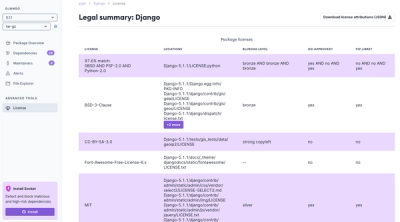
Product
Introducing License Enforcement in Socket
Ensure open-source compliance with Socket’s License Enforcement Beta. Set up your License Policy and secure your software!

Distort, bend, twist and smudge your scalable vector graphics in the browser. warp.js allows you to feed in any
SVG file and apply any kind of complex transformation.
Either download dist/warp.js from this repository and include it on your page:
<script src="warp.js"></script>
Or install through npm:
npm install warpjs --save-dev
const svg = document.getElementById('svg-element')
const warp = new Warp(svg)
warp.interpolate(4)
warp.transform(([ x, y ]) => [ x, y + 4 * Math.sin(x / 16) ])
This example creates a wave effect. Try playing with the values to see how it works.
warp.interpolate(4)
warp.transform(([ x, y ]) => [ x, y, y ])
let offset = 0
function animate()
{
warp.transform(([ x, y, oy ]) => [ x, oy + 4 * Math.sin(x / 16 + offset), oy ])
offset += 0.1
requestAnimationFrame(animate)
}
animate()
This example extends the previous by animating the wave. It takes advantage of the fact that points can be extended with additional values/dimensions. The first call to transform() doesn't actually perform any transformation – instead it extends the coordinate with a second y value. This second value won't actually affect how the SVG's path is rendered, but it can be used in subsequent transformations. When it comes to transforming the path to make the wave effect, the second y value is used as an "original position" value when calculating the new y position.
Using this concept of extending coordinates, you could use it to store velocity, acceleration, or just about anything.
transform(transformer | [transformer...])Applies a transformation (or array of transformers) to all points on the SVG. This method accepts a function for transforming the points in the SVG. The function will be passed a single argument – a coordinate array, with the first two indices containing the x and y values of that point. The function must return a coordinate array with at least two values, but it may also return more. If more values are returned than what was supplied, then that vector will be extended with those new values, and subsequent calls to transform() will supply these new values.
transformer Function that returns an array of numbers representing the new coordinateinterpolate(threshold)Intepolates the paths in the SVG with additional points for higher fidelity transformations. It divides each path segment into smaller segments until the size of those segments exceeds the threshold. Extended coordinates (see transform()) will have all values interpolated – not just the x and y pairs.
threshold The length in which segments will stop interpolationboolean Whether the method interpolated at least one segment
extrapolate(threshold)Joins path segments together if combining them results in their size being less than or equal to the threshold. Used for improving performance by reducing the number of points in the SVG. It's a lossy algorithm, so expect some quality loss when using.
threshold The length in which segments will stop extrapolationboolean Whether the method extrapolated at least one segment pair
preInterpolate(transformer, threshold)Performs interpolation on the current SVG, but uses a transformed version of that SVG to determine how the paths are interpolated. This method is used to ensure that before transformation there will be enough points to work with. It helps prevent cases where quality is lost by the transformer dramatically altering the coordinates.
transformer The transformation function to be used as a reference for interpolationthreshold The length in which segments will stop interpolationboolean Whether the method interpolated at least one segment
preExtrapolate(transformer, threshold)Performs extrapolation on the current SVG, but uses a transformed version of that SVG to determine how the paths are extrapolated. This method is used to ensure that before transformation the right segments are joined to minimize quality loss after transformation.
transformer The transformation function to be used as a reference for extrapolationthreshold The length in which segments will stop extrapolationboolean Whether the method extrapolated at least one segment pair
update()Updates the SVG elements with the new paths. Usually not necessary to call, as it is done automatically in the transform() method.
v1.0.8
Improved New logoFixed Fixed issue exposing Warp object to window contextFAQs
Warp, distort, bend, twist and smudge your SVG's directly in the browser
The npm package warpjs receives a total of 605 weekly downloads. As such, warpjs popularity was classified as not popular.
We found that warpjs demonstrated a not healthy version release cadence and project activity because the last version was released a year ago. It has 1 open source maintainer collaborating on the project.
Did you know?

Socket for GitHub automatically highlights issues in each pull request and monitors the health of all your open source dependencies. Discover the contents of your packages and block harmful activity before you install or update your dependencies.

Product
Ensure open-source compliance with Socket’s License Enforcement Beta. Set up your License Policy and secure your software!

Product
We're launching a new set of license analysis and compliance features for analyzing, managing, and complying with licenses across a range of supported languages and ecosystems.

Product
We're excited to introduce Socket Optimize, a powerful CLI command to secure open source dependencies with tested, optimized package overrides.